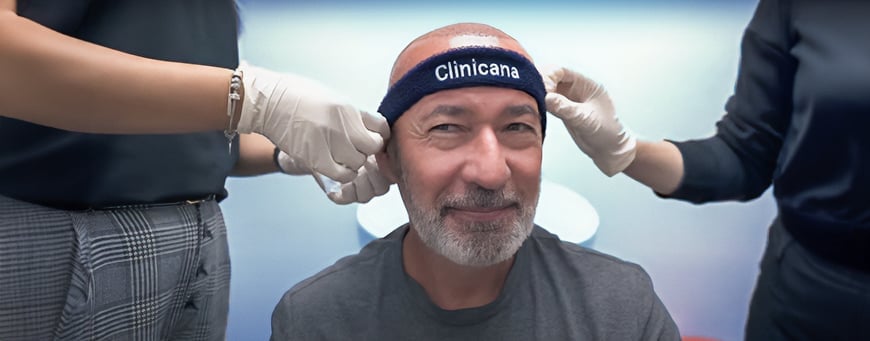Can a scalp biopsy stop hair loss?
A scalp biopsy is a procedure that is performed sometimes to establish the exact cause of alopecia when the reasons for hair loss are not clear, in order to set an appropriate treatment for the patient.
Although many people demand a hair transplant due to the positive reviews of this type of surgery, in some cases a previous scalp biopsy to determine hair loss causes may be necessary. In what cases is this technique carried out? How is it performed? What do we get with it? How long does a scalp biopsy take? And the most important: does a biopsy help to prevent alopecia? Don’t miss what follows…
In what cases is this technique carried out?
A biopsy is performed as a diagnostic test to establish with precision the causes of hair loss in a patient, and the type of alopecia that he/she presents. But a scalp biopsy for hair loss is performed only when necessary, and always by decision of the hair surgeon when he/she cannot accurately determine the pathology that the patient presents and what is causing the alopecia.
Normally, this type of procedure is performed when the hair loss pattern is different from that of male pattern hair loss – inherited baldness, which is the most common cause of alopecia – or when other symptoms are observed, such as tumours. Scalp biopsy for female hair loss cases is also common due to the difficulty in the diagnosis.
There are many different types of alopecia, and as we mentioned before, sometimes it is not easy to make a diagnosis from the mere external observation of the scalp and hair. Among the types of alopecia that usually require a biopsy for its correct diagnosis, there are the following:
- Lichen planus on the scalp
- Frontal fibrosing alopecia
- Folliculitis decalvans
- Lupus eritematoso cutáneo
- Discoid lupus erythematosus
- Alopecia mucinosa
- Graham-Little syndrome
- Pseudopelade of Brocq
- Queratosis follicularis spinulosa decalvans
By using a scalp biopsy, it is possible to obtain valuable information that will help the specialist to determine what characteristics the patient’s alopecia has; therefore, it is important to correctly identify the affected area and carry out the procedure on it. We must emphasise that a biopsy is a barely invasive and painless procedure that only lasts a few minutes. Let’s see it in more detail.
How long does a scalp biopsy take?
A scalp biopsy procedure is not very different from any other type of biopsy, since it consists of extract a tissue sample – in this case from the scalp – to later analyse it. To perform it correctly, it is a priority and essential to correctly identify the area affected by alopecia, something that in certain cases may not be easy and depends entirely on the expertise and experience of the specialist.
Once the correct area to be biopsied has been identified, a surgical cleaning is performed and a local anaesthetic is applied to the area; then one or more tissue samples are removed from the scalp using a circular scalpel between 4 and 6 millimetres in diameter.
This extraction during the scalp biopsy does not cause pain; besides, scalp biopsy has no side effects for the patient, who will be able to go back home right after the intervention. The procedure only takes a few minutes (between 15 and 30), and the only side effect for the patient is that the wound will have to be closed with one or two stitches at most, which will be removed after 10 days. No hospitalisation is required, since it is a very simple procedure.
Once the sample (or samples) has been obtained, it’s placed in a preservative solution with formaldehyde and sent to a laboratory for a histopathological analysis, and a result will be obtained after 2 or 3 weeks. With the report issued by the laboratory, the hair specialist will contact the patient to communicate him/her the results and the diagnosis of the alopecia.
What can a scalp biopsy show?
Scalp biopsy results allow to correctly diagnose the alopecia suffered by the patient, establishing both the causes of hair loss and the most appropriate treatment to correct the problem. This is essential, since although the patient may wish to get a hair transplant using the FUE technique, not all patients nor all types of alopecia are suitable for a transplant using this method.
Therefore, a biopsy can’t stop hair loss by itself, but it really can be helpful to slow down or correct it when the first symptoms appear. It also helps the hair surgeon to determine the condition of the patient’s hair and whether it has a normal growth, since the follicles and the characteristics of hair growing on the scalp are analysed during the biopsy, too.
In short, the aim of this procedure is to achieve a diagnosis as accurate as possible, since any treatment to be applied against hair loss will require months – or years – to give the expected results, and therefore any mistake in the diagnosis will mean that later it can be too late to recover hair.
It is after receiving the results of the scalp biopsy, that the experience and training of the surgeon who must make the diagnosis and find the best treatment becomes more important. Clinicana is the best hair transplant clinic in Turkey: we have one of the best hair surgeons and a medical team that has performed thousands of successful operations: request a free consultation now, and ask us for a free, no obligation estimate. You can still save your hair!

A hair transplant procedure can be a transformative experience. But to ensure your newly implanted follicles thrive, proper aftercare is very essential. This article equips you with key hair transplant recovery tips or post-operative instructions to minimize discomfort, optimize healing, and pave the way for a successful hair transplant journey for you. Hair transplant recovery […]

Dreaming of a full head of hair? Hair transplants are gaining traction, particularly in Turkey as clinics there are characterized by budget-friendly options and skilled surgeons. But, with so many clinics, the way of choosing the right one can be overwhelming. This article will help you find one of those top 10 hair transplant clinics […]

Finding the best hair transplant clinic in Istanbul is a crucial decision. In this article, we will look at some important factors to help you make an informed decision to ensure a successful surgery. How to choose the best hair transplant clinic in Istanbul? Istanbul has emerged as a sought – after destination for hair […]








